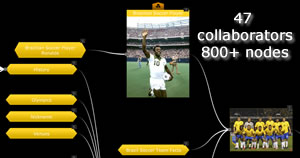 Mind mapping applications – particularly those that are web-based – offer some awesome potential for large-scale, real-time collaboration.
Mind mapping applications – particularly those that are web-based – offer some awesome potential for large-scale, real-time collaboration.
In a recent phone conversation, Mark Salamango from Spinscape shared with me two stories about his his firm and his web-based mapping/information discovery tool is already moving in that direction. In one case, 47 people were collaborating on a single map at the same time! I was so intrigued that I asked him to send me brief write-ups of both stories to share with you:
Association for Unmanned Vehicle Systems International
The Association for Unmanned Vehicle Systems International (AUVSI) “is the world’s largest organization devoted exclusively to advancing unmanned systems.” The group sponsored a conference on June 22-24, and Spinscape attended to help facilitate the panel discussions and breakout sessions.
The goal of the conference was to get 200 of the brightest minds in the growing field of unmanned systems all together in one place to discuss the future of ground robotics. The work product was a white paper that was going straight up the chain to the White House.
Several Spinscape product specialists sat in on the conference panels and captured information while discussions took place. Two large projectors provided a view of the mind maps to the attendees. Others with laptops were able to view and collaborate as the discussion progressed. At any given time, five to ten people were adding topics and information to the maps. Spinscape’s node-level security meant that conference organizers could easily give just a handful of key people access to the full map; attendees were given write access to other parts of the map (meaning they could add topics), while some sections were read-only.
On the final day, the group met to go over action items and to confirm that the document structure was sound. After the conference, attendees were given access to the mind maps so they could continue to collaborate in areas of their specific expertise. In several weeks, the map will be exported to a document, it will undergo final proofreading and OPSEC (operations security) approval and it will be sent to all participants.
The beauty of this process was that the mind map was easily organized and ideas were easily captured and viewed in a graphical way. Attendees could focus on brainstorming, structure, and content rather than taking notes. They also know that their data is safe, can be exported, and is now a “living, breathing, entity” that will continue to evolve.
World Cup soccer tournament
The Spinscape team caught a little bit of World Cup fever this year and decided it was time to create a map of all the countries in the World Cup this year. The goal (no pun intended) was to get as many people as possible adding information about World Cup teams at the same time. The result was quite cool. At one point there were 47 people working on the same map at the same time. The number of nodes on the map fluctuated quite a bit, but was up close to 800 at one point in time. This map was much more exciting than many of the games this year. Next: A map of the Tour de France!
What’s significant about these stories?
I believe that, longer term, applications like Spinscape could potentially become a new flavor of crowdsourcing tool, enabling large numbers of people to contribute ideas to a single map and to build upon the ideas of others. At the very least, I believe more robust mind mapping tools will enable larger teams to contribute to visual maps, with granular controls over who can view, edit, add topics and other access rights. The future for collaboration using this technology looks very bright indeed

Leave a Reply